Sigma 150 mm f/2.8 APO EX DG OS HSM Macro
3. Build quality and image stabilization
The Sigma 150 mm f/2.8 APO EX DG OS HSM Macro is quite big and heavy; a tripod collar, added to the set, also can hardly be called small or lightweight so it even enhances the sturdy impression (actually it might be considered an advantage as it also ensures greater stability of the whole set while attached to a tripod).In the photo below the tested lens is positioned between the Canon EF 100 mm f/3.8L Macro IS USM and the Sigma 1.4/30.
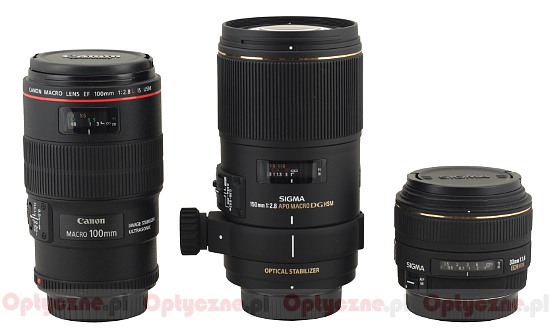 |
Please Support UsIf you enjoy our reviews and articles, and you want us to continue our work please, support our website by donating through PayPal. The funds are going to be used for paying our editorial team, renting servers, and equipping our testing studio; only that way we will be able to continue providing you interesting content for free. |
- - - - - - - - - - - - - - - - - - - - - - - - - - - - - - - - - - - - - - - - - - - - - - - -
The tested lens belongs to the EX so top-of-the-range Sigma series of lenses. Small wonder it is very solidly built and you shouldn’t expect anything else – Sigma equips even its cheapest devices with a metal mount and still produces them only in Japan.
The lens begins with a metal bayonet mount and contacts. The mount surrounds a rear element which is immobile and hidden more than 1 cm inside the casing. The rear element is almost 3 cm in diameter.
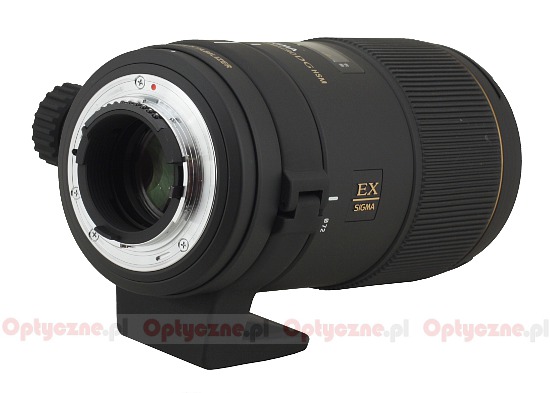 |
Already on the black, smooth casing of the lens we can locate an area with an inscription OPTICAL STABILIZER. Right behind there is a place where you put the ring of the tripod collar. Further on, you can find another inscription with the name and the parameters of the lens. On the left (looking from the top) we get a whole series of switches. The first one limits the range of the focusing mechanism. We have three ranges to choose: the full range (FULL), from 0.53 of a meter to infinity and from 0.38 of a meter to 0.53 of a meter.
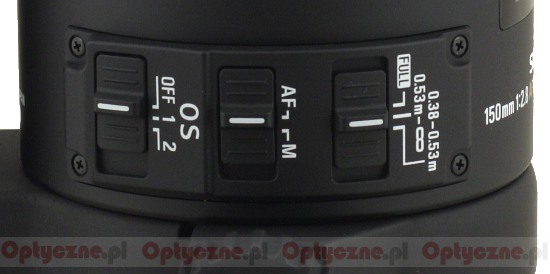 |
The next switch is used to choose the mode of the focusing mechanism (AF/MF). Even when we set the AF mode we still can move the manual focus ring. The last switch controls the optical stabilization. You can set it in the OFF position, to switch the stabilization off, or in 1 and 2 modes, which are used respectively for manual photography and photography of moving objects.
Immediately above the inscription with the name and the parameters of the lens there is a clear distance scale expressed in feet and meters. The next part of the lens consists of a manual focus ring which is as wide as 52 mm. Most of its surface is covered by rubber ribs, making the grip easier; only at the top of it there is some smooth area left for a golden stripe which is the brand name sign of the EX series. The ring itself works evenly, smoothly, with no play or wobble, allowing precise settings. The turn through less than 170 degrees is needed for covering the full range of the ring.
The other part of the lens consists of a hood thread. The hood is added in the box; what’s more it comes in two parts. When you take photos using a full frame body you use only a standard hood. If you use a body with an APS-C/DX sensor, less vignetting-prone, you can add an extension of the main hood which makes the front element hidden very deep indeed. By the way the solution looks rather risky because the whole lens set becomes almost twice as long – it can be seen in the photo below.
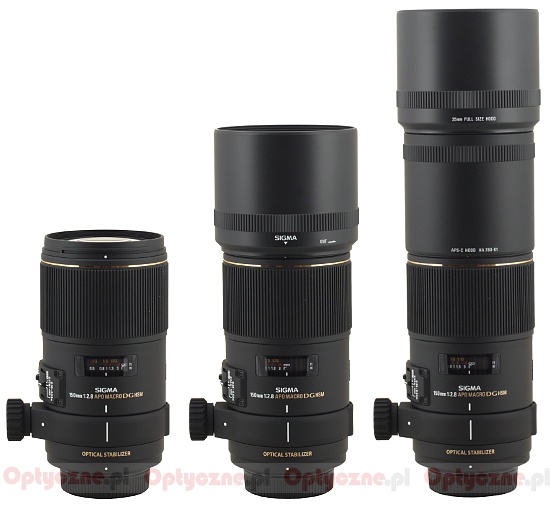 |
The front element of the lens is also immobile and 5.5 cm in diameter. It is not hidden inside the casing almost at all, only surrounded by a non-rotating filter thread, 72 mm in diameter. The fact that the front and the rear element don’t move ensures good tightness of the lens, which doesn’t suck the dust inside. On the other hand, though, the focusing is performed by changing the position of inner elements against each other so the focal length of the lens is noticeably shortened while passing to 1:1 reproduction ratio. It is also worth mentioning here that images in 1:1 ratio can be obtained when the photographed object is situated a bit further than 18 cm from the front element.
The optical construction of the Sigma 150 mm OS consists of 19 elements set in 13 groups (3 elements more than in the case of its predecessor), and as many as three elements were made of low-dispersion SLD (Special Low Dispersion) glass. Special Super Multi-Layer Coatings, used here, are supposed to ensure good performance against bright light and images with good contrast even at the maximum relative aperture. The lens is also equipped with a rounded aperture with nine diaphragm blades which can be closed down to the value of f/22.
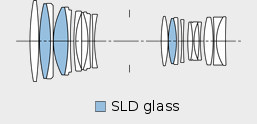
Conventionally we get a lot of accessories with a Sigma lens but this lens first of all comes with a three-year warranty period, which can be extended by next two years for additional charge. In the box you can find both caps, a hood, a hood extension, a tripod collar and a hard case with a strap. It is also worth mentioning that the tested lens can cooperate seamlessly with 1.4x and 2.0 Sigma converters.
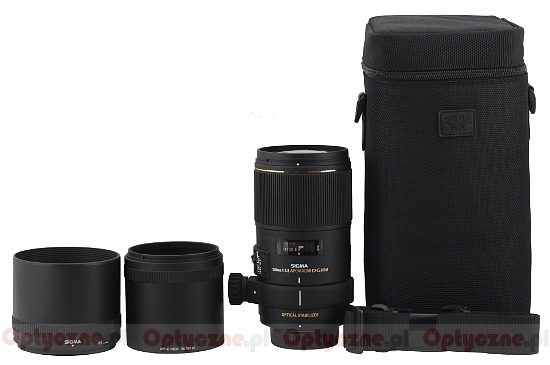 |
Stabilization
Sigma declares unvaryingly that the stabilization efficiency in its lenses reaches 4 EV. Even several years ago the real stabilization efficiency was only about 2 EV, though. The latest launches showed that the OS mechanism is being improved so its efficiency can get to and even exceed the level of 3 EV. How does the Sigma 150 mm OS fares? Let’s glance at the graph presented below.
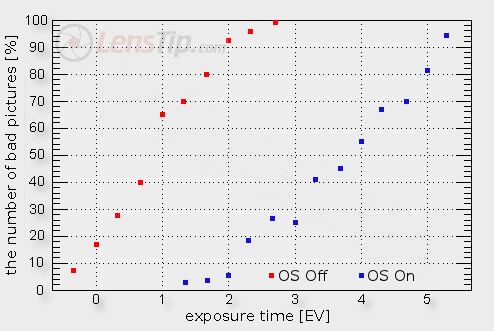
It shows the percentage of blurred photos with the stabilization switched on and off, depending on the exposure time, expressed in EV (and 0 EV is the equivalent of 1/160 of a second). As you see, the maximum distance between both curves reaches 3.3 EV and we determine the value of the new Sigma’s stabilization system as such. This result is good and the lens should be praised for it.






